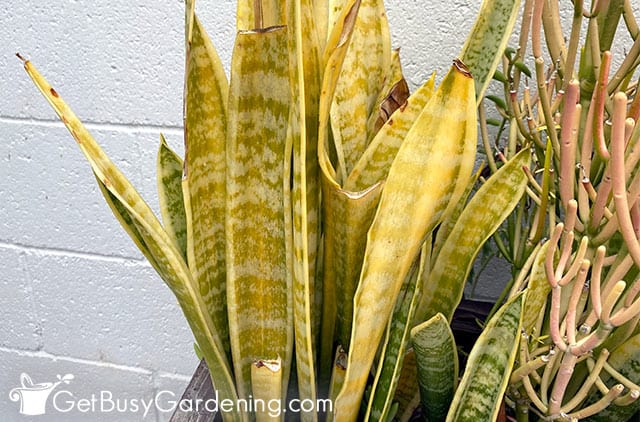The Ultimate Guide To Snake Plant Leaves Turning Yellow
Wiki Article
Not known Facts About Snake Plant Leaves Turning Yellow
Table of ContentsThe Definitive Guide to Snake Plant Leaves Turning YellowA Biased View of Snake Plant Leaves Turning YellowThe Facts About Snake Plant Leaves Turning Yellow UncoveredSome Known Incorrect Statements About Snake Plant Leaves Turning Yellow Not known Facts About Snake Plant Leaves Turning Yellow
The majority of signs of origin rot aren't visible to the exterior of a plant, besides one indication yellowing leaves. When a snake plant has yellow fallen leaves, this is commonly an indication of overwatering causing root rot. When yellow, the fallen leave is essentially dead since it's not getting any type of nutrients from the decayed origins.The best method to check if the plant needs watering is to stick your finger one inch right into the soil. If the dirt perspires, you do not require to water it. If the soil is bone completely dry, it's time to sprinkle the plant. Snake plants really function best in dryer problems than wet ones, so you must just sprinkle your serpent plant when every 7-10 days.
Rather, the natural sunlight needs to be indirect. This implies that if your snake plant rests on a windowsill or surface that is continuously in the sunlight, this is most likely the reason of the yellowing leaves. Yellow leaves indicate that the plant is burning from the sunlight, which then eventually turns brownish and crispy.
While you could presume that a window develops an obstacle to stay clear of straight sunlight, the glass really develops a magnifying impact. The sunshine will certainly then focus on certain parts of the fallen leaves, causing scorched fallen leaves. Positioning window blinds can considerably minimize the sunshine intensity! House plants call for uniformity to thrive.
Unknown Facts About Snake Plant Leaves Turning Yellow
Any kind of unexpected modifications in these demands, especially the temperature level, can lead to the tension of a plant. That's ideal stress and anxiety from drastic modifications in temperature results in yellow leaves. The primary reason to avoid putting your snake plant through constant temperature level modifications is that it completely affects the dissipation procedure.Certainly, in the onset, you may need to move the plant to locate its perfect atmosphere once it's located a home, leave it there. Just see to it the plant isn't near any home heating or cooling elements like air conditioning unit or radiators. Parasite invasions such as mealybugs and crawler mites aren't too usual in serpent plants, but they can still be the root cause of yellowing leaves.

If you assume you may have over-fertilized your snake plant, it's ideal to leave the plant alone for a few weeks to months.
Snake Plant Leaves Turning Yellow Fundamentals Explained
is pretty important for our environment-friendly good friends. It gives plants their environment-friendly shade since it mirrors green wavelengths of light. So when we look at our cherished serpent plant and its delicious, shiny fallen leaves, we're seeing the magic of chlorophyll at the office! When snake plant leaves beginning to turn yellow, it's a sign they're doing not have chlorophyll.I've seen my share of challenges with the durable Snake Plant, including the mystical yellowing of fallen leaves. Paradoxically, our excellent purposes can occasionally injure our Serpent Plant kingdoms.
: If the soil is dry, repeat the process. Think it or not, even our sturdy Serpent Plants lack their dietary supply after time. When you first buy your Snake Plant, it features a decent quantity of nutrients in its potting mix. Yet with time, like any type of other houseplant, it exhausts this supply.
Below's a helpful guide for you: from the pot. Snake Plant Leaves Turning Yellow. For a much more extensive guide on repotting, inspect out our short article on Serpent Plants are exotic locals, and they like their temperature steady and warm.
Excitement About Snake Plant Leaves Turning Yellow
Icing up temperatures can harm the fallen leaves, and high temperatures or heatwaves can quicken water loss and damage the proteins holding chlorophyll. When these healthy proteins are harmed, chlorophyll declines, and the leaves transform yellow. To treat this, ensure your Snake Plant is positioned in a location in your home with more regular temperatures.
Even the sun-loving serpent plant has its restrictions. To reduce this, move your serpent plant to a place with.

Snake Plant Leaves Turning Yellow - An Overview
Bugs and fungal infections can draw the sap from the fallen leaves, robbing the serpent plant of nutrients and triggering the fallen leaves to transform yellow. click for source The option? Relate to manage the bugs and fungal infections. Below's a fast overview Click Here to do it: neem oil from a horticulture shop. the neem oil with water complying with the suggested ratio on the bundle.Snake plant leaves are vulnerable to yellowing if the plant is not well took care of. The yellowing normally symbolizes something is incorrect with the watering and various other treatment methods. What creates the yellowing, and just how do I repair it? Healthy and balanced snake plants have a yellow tinting around the sides of their broad, upright leaf blades.
Report this wiki page